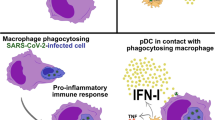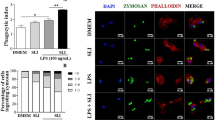Substance P Receptor Mediated Macrophage Responses (original) (raw)
- 309 Accesses
- 31 Citations
Summary
Taken together, these studies demonstrate an important role for substance P receptor expression by macrophages. The results to date suggest proinflammatory signals mediated by this receptor, and it is clear that substance P can act synergistically with other factors to stimulate macrophage activity. Antagonism of substance P/substance P receptor interactions in vivo profoundly affect immunity against Salmonella. This model provides evidence that an optimal host response against this intracellular pathogen of macrophages requires signaling through the substance P receptor. The ability of interferon gamma or IL-4 to upregulate substance P receptor mRNA expression on macrophages suggests that substance P-mediated amplification loops might involve either T helper type 1 or T helper type 2 responses. Thus, depending upon the immunologic stimulus, substance P could contribute to cell mediated as well as humoral immune responses.
Several important questions remain. Since the antigen processing and presenting function is an important macrophage activity, the effect of signaling through the substance P receptor on these events has not been defined. Furthermore, since macrophages are only one type of antigen presenting cell, it will be important to determine the role of substance P receptor expression in the activity of dendritic cells. We anticipate that these ongoing investigations will further define the positive contributions that substance P/substance P receptor interactions have in the initiation of immune responses.
Preview
Unable to display preview. Download preview PDF.
Similar content being viewed by others

Immunopathology
Chapter © 2024

References
- C.A. Maggi. The mammalian tachykinin receptors. Gen. Pharmacol. 26:911 (1995).
PubMed CAS Google Scholar - K.L. Bost, and M.J. Mason. Thapsigargin and cyclopiazonic acid initiate rapid and dramatic increases of IL-6 mRNA expression and IL-6 secretion in murine peritoneal macrophages. J. ImmunoL, 155:285 (1995).
PubMed CAS Google Scholar - I. Marriott, K.L. Bost, and M. J. Mason. Differential kinetics for induction of IL-6 mRNA expression in murine peritoneal macrophages: evidence for calcium dependent and independent signaling pathways. J. Cell. Physiol. 177:232 (1998).
Article PubMed CAS Google Scholar - I. Marriott, M.J. Mason, A. Elhofy, and K.L. Bost. Substance P activates NF-kB independent of elevations in intracellular calcium in murine macrophages and dendritic cells. J. Neuroimmmol. in press, 2000.
Google Scholar - U. Gubler, A.O. Chua, D.S. Schoenhaut, C.M. Dwyer, W. McComas, R. Motyka, N. Nabavi, A.G. Wolitzky, P.M. Wuinn, P.C. Familletti, and M.K. Gately. 1991. Coexpression of two distinct genes is required to generate secreted bioactive cytotoxic lymphocyte maturation factor. Proc. Natl. Acad. Sci. (USA) 88:4143 (1991).
CAS Google Scholar - K.L. Bost, and J.D. Clements. Intracellular Salmonella dublin induces substantial secretion of the 40-kilodalton subunit of Interleukin-12 (IL-12) but minimal secretion of IL-12 as a 70-kilodalton protein in murine macrophages. Infect. Immun. 65:3186 (1997).
PubMed CAS Google Scholar - T. Kincy-Cain, and K.L. Bost. Substance P-induced IL-12 production by murine macrophages. J. Immunol. 158:2334 (1997).
PubMed CAS Google Scholar - T. Kincy-Cain, J.D. Clements, and K.L. Bost. Endogenous and exogenous interleukin-12 augment the protective immune response in mice orally challenged with Salmonella dublin. Infect. Immun. 64:1437 (1996).
PubMed CAS Google Scholar - S.M. Wahl. Transforming growth factor beta: the good, the bad, and the ugly. J. Exp. Med. 180:1587 (1994).
Article PubMed CAS Google Scholar - I. Marriott, and K.L. Bost. Substance P dramatically diminishes lipopolysaccharide and interferongamma induced TGF beta-1 production by cultured murine macrophages. Cell. Immunol. 183:113 (1998).
Article PubMed CAS Google Scholar - K.L. Bost. Expression of preprotachykinin mRNAs in lymphoid organs of normal and orally immunized mice: involvement of macrophages in preprotachykinin mRNA expression in vivo. J. Neuroimmunol. 62:59 (1995).
Article PubMed CAS Google Scholar - D.W. Pascual, and K.L. Bost. Substance P production by P388D1 macrophages: a possible autocrine mechanism of interaction. Immunology 71:52 (1990).
PubMed CAS Google Scholar - T. Kincy-Cain, and K.L. Bost. Increased susceptibility of mice to Salmonella infection following in vivo treatment with the substance P antagonist, spantide II. J. Immunol. 157:255 (1996).
PubMed CAS Google Scholar - M. Fitzgerald. Capsaicin and sensory neurons-a review. Pain 15:109 (1983).
Article PubMed CAS Google Scholar - K.L. Bost, and D.W. Pascual. Substance P: a late acting B lymphocyte differentiation co-factor. Am. J. Physiol. 262:C537 (1992).
PubMed CAS Google Scholar
Author information
Authors and Affiliations
- Department of Biology, University of North Carolina at Charlotte, Charlotte, NC, 28223
Ian Marriott & Kenneth L. Bost
Authors
- Ian Marriott
You can also search for this author inPubMed Google Scholar - Kenneth L. Bost
You can also search for this author inPubMed Google Scholar
Editor information
Editors and Affiliations
- College of Medicine, University of South Florida, Tampa, Florida
Herman Friedman & Thomas W. Klein & - Georgia Mental Health Institute, Emory University, Atlanta, Georgia
John J. Madden
Rights and permissions
Copyright information
© 2002 Kluwer Academic Publishers
About this chapter
Cite this chapter
Marriott, I., Bost, K.L. (2002). Substance P Receptor Mediated Macrophage Responses. In: Friedman, H., Klein, T.W., Madden, J.J. (eds) Neuroimmune Circuits, Drugs of Abuse, and Infectious Diseases. Advances in Experimental Medicine and Biology, vol 493. Springer, Boston, MA. https://doi.org/10.1007/0-306-47611-8\_30
Download citation
- .RIS
- .ENW
- .BIB
- DOI: https://doi.org/10.1007/0-306-47611-8\_30
- Publisher Name: Springer, Boston, MA
- Print ISBN: 978-0-306-46466-9
- Online ISBN: 978-0-306-47611-2
- eBook Packages: Springer Book Archive
